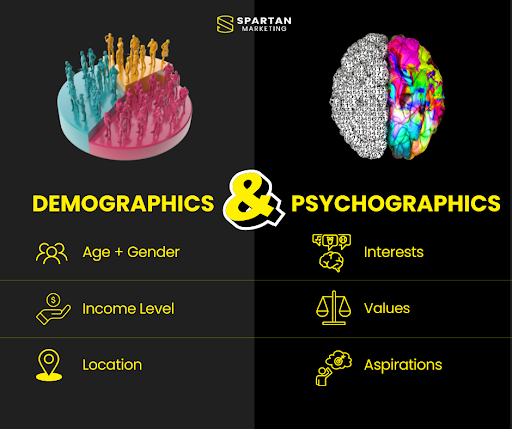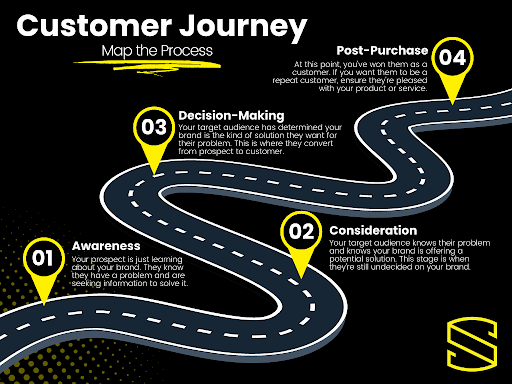Are you tired of wasting your marketing efforts on the wrong audience? Want to ensure your message reaches those most likely to engage with your brand? If so, then it’s time to focus on targeting your ideal customer. By understanding who your ideal customer is and tailoring your marketing strategies specifically for them, you can maximize your return on investment and drive meaningful results. Below, we’ll explore five tips for effectively targeting your ideal customer. Let’s dive in!
The Importance of Targeting Your Ideal Customer
In today’s saturated market, it’s no longer enough to cast a wide net and hope for the best. To achieve success, you need to laser-focus your efforts on those most likely to connect with your brand and become loyal customers. This is where targeting your ideal customer becomes crucial.
Targeting your ideal customer involves identifying the demographic, psychographic, and behavioral characteristics defining your most valuable audience segment. You can increase engagement, build brand loyalty, and drive conversions by tailoring your messaging, content, and strategies to speak directly to this target group.

#1 Identify Your Ideal Customer and Their Pain Points
Before targeting your ideal customer, you must understand who they are and their unique challenges. You can create compelling marketing campaigns that resonate deeply with them by gaining insight into their pain points, desires, and motivations.
Conduct Market Research to Uncover Pain Points
Once you have a clear picture of your ideal customer, it’s time to delve deeper into their pain points—the challenges, frustrations, or problems they face that your product or service can solve. Conducting thorough market research, including surveys, interviews, and social listening, can help uncover these pain points and better understand your target audience.
Market research doesn’t have to be hard. With Spartan Marketing, we can take this off your plate and find your customer persona and pain points without you ever having to lift a finger.
Let’s say you run a home organizing service. Through market research, you discover that one of the most significant pain points for busy professionals is finding time to declutter their homes. With this insight, you can create targeted content and campaigns that address this specific challenge and position your service as the solution they need.

Craft a Compelling Customer Persona
Developing a detailed customer persona is essential—a fictional representation of your ideal customer. Consider demographics such as age, gender, income level, and location, and psychographics like interests, values, and aspirations. Doing this helps create targeted marketing messages that appeal directly to your intended audience.
For example, let’s say you run a fitness apparel brand. Your ideal customer persona might be Sarah—an active, health-conscious woman in her mid-30s who enjoys outdoor activities and values sustainable fashion. By keeping Sarah in mind during your marketing planning, you can tailor your messaging to address her unique needs and preferences.
Address Pain Points in Your Messaging
Now that you have identified your ideal customer’s pain points, addressing them directly in your marketing messaging is crucial. Highlight how your product or service can alleviate their frustrations and make their lives easier. Craft compelling headlines, copy, and visuals that grab their attention and communicate your value.
If we continue with the home organizing service example, your marketing messaging could emphasize the benefits of a clutter-free space, such as reduced stress, increased productivity, and more free time. By speaking directly to the pain points and demonstrating how your service can provide relief, you can capture the interest and engagement of your ideal customers.
#2 Map the Customer’s Journey to Guide Your Marketing
Understanding the customer journey—the path your ideal customer takes from initial awareness to purchase—is essential for effective targeting. By mapping out this journey, you can identify touchpoints, potential obstacles, and opportunities for strategic interventions.
Understand the Customer’s Path from Awareness to Purchase

The customer journey typically consists of several stages: awareness, consideration, decision-making, and post-purchase. Each stage presents unique challenges and opportunities for marketers. You can align your marketing efforts by understanding how your ideal customer moves through these stages.
For instance, during the awareness stage, your target audience may seek information or solutions to their problem. You can establish credibility and capture their attention by creating educational blog posts, videos, or social media content that provide value and position your brand as a trusted resource.
Map Out Touchpoints and Potential Obstacles
Once you understand the customer journey stages, you must identify the touchpoints—interactions or points of contact between your brand and your ideal customer. These touchpoints may include website visits, social media interactions, email communications, or in-store experiences.
As you map out these touchpoints, consider potential obstacles or challenges your ideal customer might encounter. Is your website navigation intuitive? Are your call-to-action buttons clear and compelling? By proactively addressing these potential obstacles, you can ensure a seamless and positive customer experience throughout the journey.
Unsure how you can make your email marketing target the ideal customer? Dig deeper with Spartan Marketing’s 6 Creative Emails to Inspire Your Next Campaign.
Tailor Marketing Strategies to Each Stage of the Journey
With a comprehensive understanding of the customer journey and its touchpoints, it’s time to tailor your marketing strategies to each stage. For example:
- During the awareness stage, focus on providing valuable content and building brand recognition.
- In the consideration stage, highlight your product or service’s unique features and benefits compared to competitors.
- When customers are making decisions, offer incentives, testimonials, or case studies that reinforce their choice.
- Finally, during the post-purchase stage, continue to engage with personalized communication and provide excellent customer service to encourage loyalty and repeat purchases.
By customizing your strategies for each stage of the customer journey, you can guide your ideal customers seamlessly toward purchasing while fostering long-term relationships.
#3 Refine Your Funnel(s) and Segment Your Targets
Crafting a detailed customer avatar—an individual representation of your ideal customer—is another powerful technique for effective targeting. This process involves creating a vivid profile encompassing various characteristics, interests, preferences, and behaviors. Let’s explore how this approach can improve your targeting efforts.
Segment Your Audience for Personalized Marketing
Building upon the customer avatar concept, segmenting your audience based on various characteristics can further enhance your targeting efforts. Instead of treating all customers as one homogenous group, divide them into smaller segments with similar attributes or preferences.
Continuing with the pet grooming salon example, you could segment your audience by pet type, offering specialized messaging for dog owners, cat owners, and bird owners. By delivering personalized content and offers tailored to each segment, you demonstrate that you understand their unique needs and preferences, increasing the likelihood of engagement and conversion.
An easy way to segment your audience is to use automations. Each click, open, like, or share can be tracked to label the prospect appropriately. It may take a bit to set up, but once it’s done, you’ll have a machine that tracks and segments your customers based on their preferences, making targeting them for specific campaigns easier and more effective.
Tailored Marketing Sometimes Requires Multiple Funnels
We all love a one-size-fits-all marketing funnel. However, these types of funnels, though easy, don’t always get the kind of engagement you’re looking for. Don’t be afraid to break your approach into multiple paths. Creating distinct marketing funnels for various customer segments and products is crucial for a successful marketing strategy. These tailored funnels enable businesses to deliver highly targeted messaging that resonates with each specific audience. By addressing the unique needs, preferences, and pain points of different customer groups, companies can significantly increase conversion rates and provide a superior customer experience.
Customizing funnels allows for efficient resource allocation, as marketing efforts can be focused on the most effective channels and strategies for each segment. This approach also yields valuable data for refining marketing tactics, enabling more effective cross-selling and upselling to existing customers. Ultimately, personalized funnels provide a competitive advantage by standing out in a sea of generic marketing approaches, driving better engagement, higher conversion rates, and increased customer loyalty.

Use Data and Analytics to Refine Your Targeting
As technology advances, so does our ability to collect and analyze data to refine our understanding of the target audience. Take advantage of analytics tools and software that provide valuable insights into consumer behavior, online interactions, and purchasing patterns.
You can update and refine your targeting goals by analyzing this data regularly. Discover emerging trends, evolving preferences, or new pain points that may impact your targeting strategy. Stay nimble and responsive to changes in your industry and adapt your approach to ensure maximum effectiveness.
#4 Use Customer Feedback to Drive Strategy
Customer feedback is a goldmine of information that can guide your marketing strategies and drive better results. By actively seeking feedback and leveraging it to refine your approach, you can foster stronger customer relationships while continuously improving your offerings.
Add Feedback Loops to Gather Insights
To gather valuable customer feedback, consider implementing feedback loops throughout the customer journey. These could include post-purchase surveys, online reviews and testimonials, social media engagement, or direct communication channels like email or chatbots.
Encourage customers to share their opinions and experiences openly. Ask for suggestions on improving, what they appreciate about your brand, and any pain points they’ve encountered. By creating a culture of open dialogue, you demonstrate that you value their input and are committed to providing the best experience possible.
Analyze Feedback to Identify Areas for Improvement
Once you have collected customer feedback, take the time to analyze it carefully. Look for patterns, recurring themes, and insights that shed light on areas where you can improve. Are there specific pain points consistently mentioned? Are there opportunities to enhance certain aspects of your product or service?
By identifying these areas for improvement, you can fine-tune your marketing strategies and offerings to better align with your customers’ needs and expectations. This iterative process ensures you remain agile and responsive in an ever-changing market landscape.
Incorporate Customer Feedback into Your Marketing Strategies
Finally, don’t let valuable customer feedback go to waste—put it to use! Leverage the insights gained from feedback to inform your marketing strategies. Consider incorporating testimonials and reviews into your website and promotional materials to build trust and social proof. Highlight improvements based on customer suggestions to demonstrate your commitment to continuous improvement.
Integrating customer feedback into your marketing strategies creates a virtuous cycle where your efforts directly address customer needs and desires. This fosters loyalty and long-term satisfaction, setting the stage for increased conversions and advocacy.
#5 Communicate Your Value Proposition to the Ideal Customer
Once you have identified your ideal customer, crafted compelling messaging, and mapped out the customer journey, it’s time to communicate your brand’s value proposition. Articulate what sets your brand apart and how it can benefit your target audience to capture their attention and differentiate yourself from competitors.
Understand What Sets Your Brand Apart
To communicate your value proposition, it’s essential to understand what makes your brand unique. Consider your key differentiators—the qualities, features, or benefits that set you apart from competitors. Do you offer superior quality, innovative solutions, exceptional customer service, or a more sustainable approach?
By pinpointing your unique selling points, you can create messaging that resonates with your ideal customers and convinces them of your brand’s superiority over other options.
Craft a Clear and Compelling Value Proposition
Now that you understand what sets your brand apart, craft a clear and compelling value proposition that communicates this distinctiveness concisely. Use simple language and focus on the primary benefit your target audience will receive by choosing your brand.
For example, if you offer eco-friendly cleaning products, your value proposition might be: “Discover a cleaner future with our environmentally conscious cleaning products—powerful performance without harming the planet.” This statement succinctly conveys the core message while highlighting the critical customer benefit.
Align Your Messaging Across Channels
Consistency is key when communicating your value proposition across various marketing channels. Ensure your messaging remains consistent in tone, voice, and visual elements across platforms such as your website, social media, email campaigns, and advertising.
When your target audience encounters your brand in multiple touchpoints, consistency builds trust and reinforces your value proposition. It helps solidify your brand image and ensures a coherent experience throughout the entire customer journey.
Unlock Success Through Effective Customer Targeting
Targeting your ideal customer is a strategic endeavor that requires a deep understanding of your audience, their pain points, and their journey toward purchasing. By following the tips outlined in this article—identifying your ideal customer, crafting a customer journey map, building a customer avatar, leveraging customer feedback, and communicating your value proposition—, you can unlock success by reaching and engaging those most likely to become loyal customers.
How can you apply these targeting strategies to your own business? What changes can you make to better connect with your ideal customer?
These tips may seem time-consuming or too in-depth to incorporate into your busy schedule. However, skipping them wastes their potential for conversions and costs you big money. Luckily, there’s Spartan Marketing. We can bridge the gap between you and your customer, nurturing your relationship and making conversion all the more likely. Embrace the power of understanding your audience and refining your strategies based on their needs, preferences, and behaviors. By focusing on delivering value and relevance to your target audience, Spartan Marketing can help you forge stronger connections, increase conversions, and achieve sustainable growth.
What’s next for your targeting strategy? Reach out to Spartan Marketing and watch your efforts yield remarkable results.

